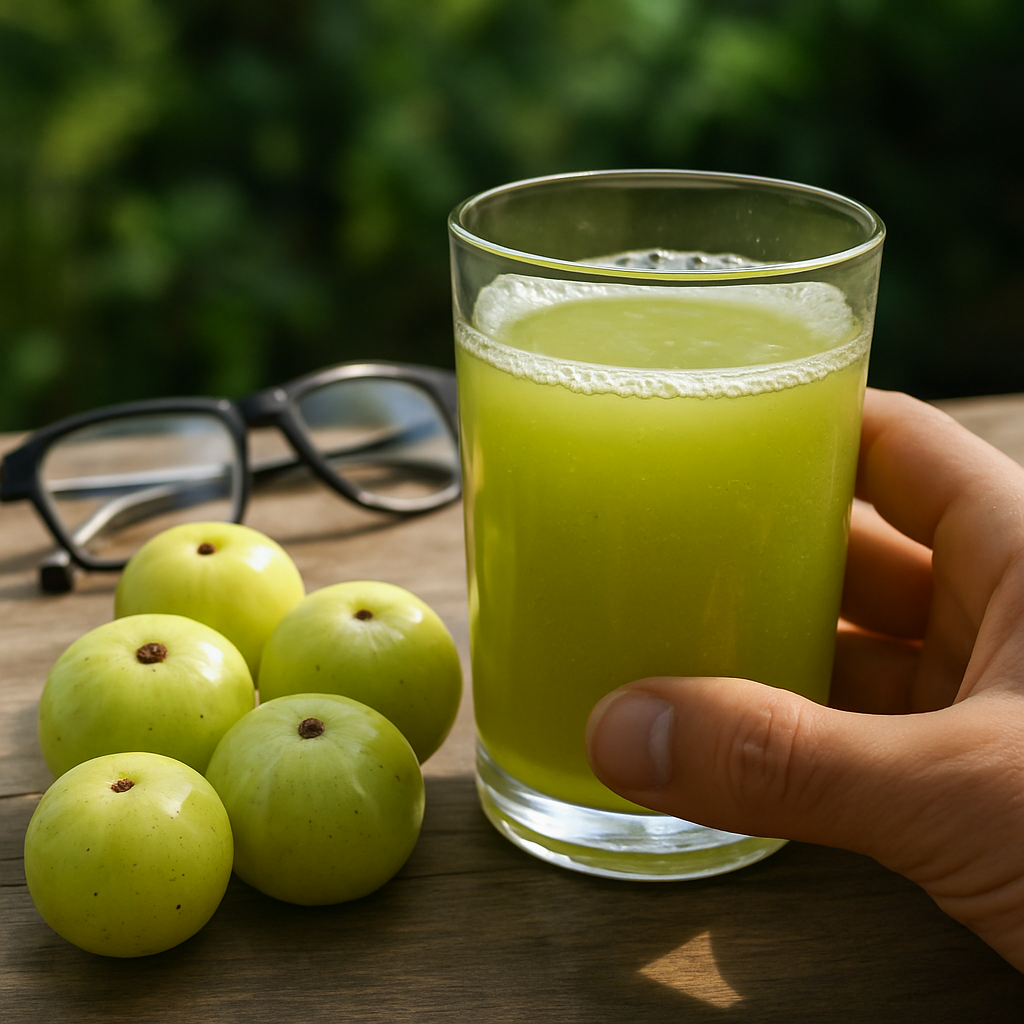Shop Now in Our Store
Is Amla Good for Eyes and Vision Health?

When it comes to natural remedies for keeping your eyes healthy, one fruit keeps popping up again and again: amla (also known as Indian gooseberry). People often wonder, is amla good for eyes? or does amla improve eyesight? The truth is, this small, tangy fruit has been valued in Ayurveda for centuries, and modern research is finally catching up. From boosting overall wellness to protecting delicate eye tissues, amla benefits for eyes are both wide-ranging and deeply fascinating.
If you’ve ever asked yourself questions like is amla good for eyesight, how to use amla for eyesight, or can amla improve eyesight naturally, then you’re in the right place. This guide will walk you through traditional Ayurvedic insights, modern nutritional findings, practical tips, and even a few cautions you should know before adding amla to your eye care routine.

Is Amla Good for Eyes: Ayurvedic and Nutritional View
Amla for Eyes in Traditional Ayurveda
In Ayurveda, amla has always been considered a “rasayana” — a rejuvenator for the body and mind. Ancient texts mention that amla for eyes helps balance the body’s doshas (especially Pitta), which directly connects to vision health. Healers believed that consuming amla regularly could keep the eyes cool, reduce strain, and sharpen clarity. Some even used amla paste in herbal formulations for topical application around the eyes, although this isn’t common today.
The idea wasn’t just spiritual or symbolic; Ayurveda linked eye problems to excessive heat and stress in the body, and amla’s cooling, antioxidant-rich nature was thought to neutralize these imbalances.
Modern Research on Amla Benefits for Eyesight
Fast forward to today, and science is backing up many of those claims. Amla is packed with vitamin C, a nutrient essential for maintaining healthy connective tissue in the eyes. It also helps fight free radicals that damage the retina and lens. Modern studies have shown that antioxidants like those found in amla may reduce the risk of cataracts and age-related macular degeneration.
So, when people ask, is amla good for eyesight? the answer is yes — both Ayurveda and modern nutrition agree that amla plays a significant role. However, it’s not a magic bullet; it works best as part of a balanced diet and lifestyle.

Key Amla Benefits for Eyesight and Vision Health
Does Amla Improve Eyesight and How It Works
Now, the big question: does amla improve eyesight? The truth is, it can help in multiple ways. First, its high vitamin C content supports collagen production, which keeps the cornea and blood vessels in the eyes strong. Second, its antioxidants fight oxidative stress, slowing down damage that naturally accumulates with age.
While you shouldn’t expect amla to turn weak eyes into perfect 20/20 vision overnight (that’s a myth some blogs exaggerate!!), it can certainly improve overall eye health, reduce strain from screens, and keep your eyesight sharper for longer. Many people who consume amla daily report fewer complaints of dryness, burning, or tired eyes.
Amla Juice Benefits for Eyes and Overall Eye Care
One of the most popular ways people consume it is through amla juice for eyes. Freshly extracted juice delivers nutrients quickly, and some believe it provides faster benefits compared to dried or powdered forms. Drinking a small glass in the morning is said to brighten the eyes, reduce redness, and support night vision.
That said, moderation matters. Too much amla juice may upset the stomach because of its acidity. Also, avoid bottled versions with added sugar, as they cancel out many of the amla juice benefits for eyes.

How to Use Amla for Eyesight Improvement
So far, we’ve looked at the science and Ayurvedic background. But the real question many people ask is: how to use amla for eyesight in daily life? The good news is, there are several easy and practical ways to add it into your diet without making it complicated.
How to Use Amla for Eyesight in Daily Diet
The simplest method is to eat raw amla fruit when it’s in season. Its taste is sour and tangy — not exactly everyone’s favorite, but definitely worth it for the benefits. If raw fruit feels too harsh, you can sprinkle a little salt or honey to make it palatable.
Another common way is using amla powder. Just half a teaspoon mixed into warm water or added to smoothies can provide daily support for your eyes. Amla candy (the dried, sweetened version) is also popular, especially among kids, although it’s less potent than fresh fruit or powder.
For people asking is amla good for eyesight in children? — yes, it can be, as long as you keep portions small and avoid heavily sweetened versions. Natural amla or a little powder in milk can be a great choice for young ones.
Amla Juice for Eyes: Preparation and Usage Tips
Now, about juice. Amla juice for eyesight is one of the most talked-about remedies. To prepare it at home, wash 2–3 fresh amlas, cut them, remove the seeds, and blend with water. Strain and drink immediately, preferably on an empty stomach in the morning.
Some people add a few drops of honey or dilute it with warm water to soften the sharp taste. Drinking amla juice 3–4 times a week is usually enough to see results, but some prefer it daily in smaller amounts.
A few practical tips:
-
Always go for fresh or homemade juice rather than store-bought.
-
If you’re trying it specifically for eye health, avoid mixing it with too many other fruits; pure amla juice is best.
-
Try not to overdo it — around 20–30 ml a day is more than enough.
This way, you get the amla juice benefits for eyes without straining your stomach.
When Amla Juice May Not Be Suitable for Eyes
Although amla is good for eyes, there are certain situations where caution is needed. People with very sensitive stomachs or a history of acid reflux might find amla juice too strong. In such cases, it’s better to try amla powder in warm water or mix small amounts with honey.
Also, if you’re taking medications for blood thinning or diabetes, consult a doctor before making amla juice a daily habit. Its natural compounds can sometimes interact with medicines.
So, while the benefits of amla for eyes are impressive, it’s important to remember that “more” is not always “better.” Moderation and balance are key.
Conclusion
So, is amla good for eyesight? Absolutely. Whether eaten raw, taken as powder, or sipped as juice, it provides your eyes with essential nutrients, antioxidants, and protection against age-related damage. But remember — it’s not a miracle cure. Think of it as one powerful piece in the puzzle of good vision health, alongside proper rest, hydration, and reducing screen strain.
By making amla part of your regular diet, you’re investing in long-term vision support. And honestly, with so many easy ways to consume it, there’s no reason not to give it a try.
FAQs
How to use amla for eyesight without side effects?
The safest way is to start small. Instead of drinking a full glass of juice right away, try 20–30 ml diluted in water a few times a week. You can also sprinkle half a teaspoon of amla powder in warm water or mix it into smoothies. Avoid overuse, as too much vitamin C at once may upset the stomach.
Does amla help with age-related vision problems?
Yes, but with realistic expectations. Amla benefits for eyes include slowing down oxidative stress, protecting the retina, and supporting healthy blood circulation — all of which matter as we age. While it’s not going to reverse severe conditions like macular degeneration, regular use can reduce risk and support overall vision health. Think of it as a preventive shield more than a cure.
Is amla good for eyesight in children?
In moderation, yes. For kids, amla can provide extra vitamin C and antioxidants that support healthy growth and vision. However, don’t give them large amounts of raw juice — its sourness can be too harsh. Instead, small amounts of amla powder mixed in milk or a little piece of fresh fruit once in a while is usually safe and effective.
If you found this guide useful, don’t just keep it to yourself — share it with friends and family who spend hours on screens or struggle with tired eyes. Amla is one of those rare remedies that’s both traditional and scientifically respected, making it a perfect conversation starter.
Why not give it a try this week? Add a little amla to your morning routine and see how your eyes feel after a few weeks. You might just discover that this humble fruit becomes one of your favorite natural health allies.
This article is checked by the current qualified Dr Sujal Patil and can be considered a reliable source of information for users of the site.
Got any more questions?
Ask Ayurvedic doctor a question and get a consultation online on the problem of your concern in a free or paid mode.
More than 2,000 experienced doctors work and wait for your questions on our site and help users to solve their health problems every day.

